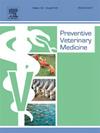Heterogeneous distribution of the reported prevalence of Dirofilaria immitis infections in Australian canids – A systematic review and meta-analysis
IF 2.2
2区 农林科学
Q1 VETERINARY SCIENCES
引用次数: 0
Abstract
Reports of Dirofilaria immitis infection vary by location in the USA and Europe, with an occurrence gradient increasing towards the equator and warmer climates. In Australia, heartworm preventative guidelines are not climate specific, implying homogenous risk of infection across the continent. We systematically reviewed the published literature to assess if the distribution of D. immitis infection varies in Australia. We sourced 41 relevant publications by searching multiple bibliographic databases and the citations of key articles. From those, we extracted the data from a total of 106 individual surveys of variable size and quality. The reported prevalences ranged from 0.0 % to 100.0 % and we meta-analysed the observed heterogeneity using survey location’s latitude, climate zone or temperature/humidity zone. Crude heterogeneity between surveys was partly explained (approximately 30 %) by temperature/humidity zone, and the quality of the surveys did not affect the proportional explanation of heterogeneity. There was significantly higher pooled prevalence in humid summer zones (18.7 %, 95 %CI: 10.9–30.1 %) compared to cool winter zones (2.1 %, 95 %CI: 1.0–4.3 %). Historical reports of D. immitis infection in Australia concur with the strong association to warmer climates observed in other continents. The current blanket recommendation for dirofilariosis preventative usage does not reflect the important variability of infection risk to canids across locations of Australia.
求助全文
约1分钟内获得全文
求助全文
来源期刊

Preventive veterinary medicine
农林科学-兽医学
CiteScore
5.60
自引率
7.70%
发文量
184
审稿时长
3 months
期刊介绍:
Preventive Veterinary Medicine is one of the leading international resources for scientific reports on animal health programs and preventive veterinary medicine. The journal follows the guidelines for standardizing and strengthening the reporting of biomedical research which are available from the CONSORT, MOOSE, PRISMA, REFLECT, STARD, and STROBE statements. The journal focuses on:
Epidemiology of health events relevant to domestic and wild animals;
Economic impacts of epidemic and endemic animal and zoonotic diseases;
Latest methods and approaches in veterinary epidemiology;
Disease and infection control or eradication measures;
The "One Health" concept and the relationships between veterinary medicine, human health, animal-production systems, and the environment;
Development of new techniques in surveillance systems and diagnosis;
Evaluation and control of diseases in animal populations.
 求助内容:
求助内容: 应助结果提醒方式:
应助结果提醒方式:


